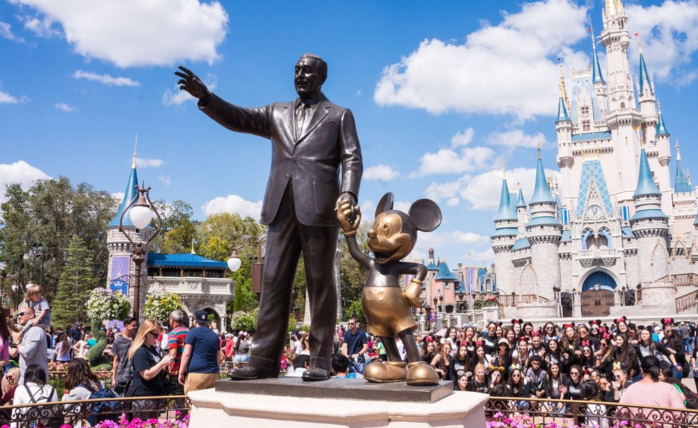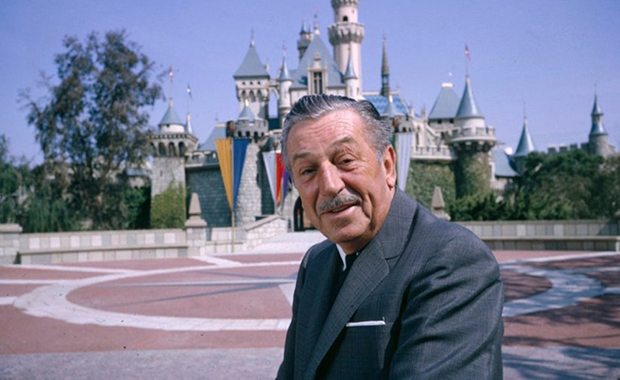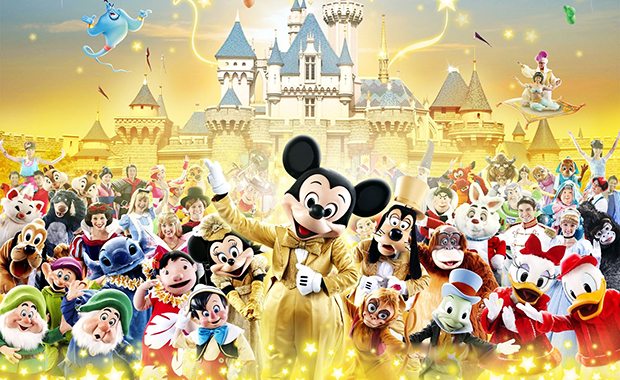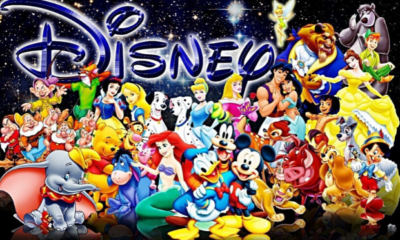Success Advice
25 Lessons from Walt Disney’s Billion Dollar Business Playbook
Disney’s journey offers a blueprint for overcoming doubt, pushing boundaries, and creating something that will resonate for generations

Imagine this: you’re at the threshold of an empire—a world where creativity reigns, innovation sweeps across every corner, and resilience holds it all together. This is Walt Disney’s creation, an entertainment colossus that didn’t just transform an industry but set new standards for what’s possible.
Entrepreneurs, high achievers, trailblazers: if you’re chasing a legacy that outlives you, step inside and uncover how Disney leveraged purpose, risk-taking, and relentless dedication to bring ideas to life.
This isn’t just about cartoons or castles. It’s a story of resilience through adversity, unwavering belief in a grand vision, and innovation born out of setbacks. It’s about betting big on your dreams and making the world believe in them too.
Disney’s journey offers a blueprint for overcoming doubt, pushing boundaries, and creating something that will resonate for generations. Ready to embrace these lessons and transform your journey?
Dive into 25 invaluable insights that will challenge your thinking, refine your strategy, and amplify your impact.
1. Pioneering the Multimedia Corporation:
Walt Disney innovatively bundled various forms of entertainment under one corporate umbrella, creating the first modern multimedia corporation. He harnessed the collective power of animation, live-action films, television, theme parks, music, books, comics, merchandise, and educational content to build an unprecedented entertainment empire.
Takeaway: Look for ways to integrate different aspects of your work or passions. A combination of unique skills and ideas can create something entirely new.
2. Commitment to Innovation and Vision:
Disney expanded the boundaries of art and entertainment, developing new artistic forms, such as feature-length animated films, and exploring new frontiers like amusement parks, color TV, conservation, and space exploration. His vision drove advances in color film and color television, and his creative reimagining of amusement parks shaped the industry for generations.
Takeaway: Keep exploring new frontiers, even when others think it’s impossible. Never let the fear of failure limit your ambition.
3. Resilience and Determination:
Disney’s childhood experiences, particularly his father’s controlling and unsuccessful nature, instilled in him a “sadistic determination” that fueled his ambition. Despite early setbacks and limited support, Disney overcame adversity through sheer willpower, striving to break free from the failures of his past.
Takeaway: Learn to turn adversity into fuel. Obstacles and difficult circumstances can either break you or push you to new heights. Embrace the challenges as opportunities to grow.
4. Building a Legacy Through Personal Transformation:
Walt Disney created himself and a new world from his challenging upbringing. He remained focused on personal transformation, escaping the shadow of his father’s failures and embodying the opposite qualities. He refused to perpetuate the cycle of abuse, treating his children with care and nurturing, unlike his father.
Takeaway: Your past doesn’t define your future. Break free from limiting beliefs and patterns to create a life you envision, not one shaped by past traumas.
5. Faith in Self and Purpose:
From a young age, Disney brimmed with confidence and faith in his ability, even before he had a fully developed plan. This unshakable belief helped him navigate uncertainty and setbacks, keeping him focused on achieving significant and meaningful goals.
Takeaway: Believe in your potential even when the road ahead isn’t clear. Confidence in yourself and your goals will help you navigate challenges.
6. Mastery and Total Immersion:
Walt Disney embraced animation as an art form, immersing himself completely to master it. He read every available book, took courses, and practiced intensely. This total commitment allowed him to gradually evolve from producing short, simple, black-and-white cartoons to creating full-length, colorful, and sound-enhanced feature animations.
Takeaway: Commit fully to mastering your craft. Dive in headfirst, learn, and practice intensely to continuously evolve and reach new levels.
7. Unwavering Self-Confidence:
Despite external skepticism and lack of market demand for animated cartoons, Disney maintained extraordinary self-belief and relentless determination. He was willing to live in his office and work tirelessly, often relying on credit for food and showering once a week to stay focused on his goals.
Takeaway: Keep your eye on your goals, even when others doubt you. Consistent belief in yourself will fuel your journey through difficult moments.
8. Overcoming Betrayal with Innovation:
After losing his original characters and staff to Charles Mintz, Disney rebounded by innovating and creating Mickey Mouse. He recognized that setbacks often bring new opportunities and used this adversity to fuel his creativity, ultimately developing the first sound cartoon, “Steamboat Willie.”
Takeaway: Setbacks are opportunities in disguise. When things go wrong, think outside the box, adapt, and innovate to find a new way forward.
9. Control and Quality:
Disney realized the importance of controlling his characters and creative output to prevent another betrayal like the one he faced with Mintz. He insisted on unparalleled quality, considering it the key to capturing and retaining public interest in Disney films. His meticulous standards ensured that Disney’s productions were unmatched.
Takeaway: Maintain control over your output and hold yourself to high standards. Quality is what sets you apart and builds your reputation.
10. Training the Elite:
Disney built a culture of excellence by training and educating his own team, believing in enthusiasm over experience. He created a sense of belonging and pride among his staff, making them feel like an elite unit with a shared commitment to deliver top-quality animation.
Takeaway: Surround yourself with people who are enthusiastic about your vision. When you build a strong team aligned with your mission, excellence follows.
11. Uncompromising Dedication to Excellence:
Walt Disney insisted that his animations be better than anyone else’s, believing this unwavering commitment to excellence was his business strategy. He never sought profits directly but focused on creating work he could be proud of, tirelessly working late into the night to ensure the best possible quality.
Takeaway: Strive to be proud of your work. Focus on creating something remarkable instead of chasing profits, and the rewards will follow.
12. Divine Discontent and Relentless Improvement:
Disney had a habit of divine discontent, constantly striving for improvement and never being satisfied with the finished product. He often critiqued past work, identifying mistakes and finding ways he could have made it better, a mindset that sometimes led to nervous breakdowns due to immense pressure.
Takeaway: Never settle. Continuously evaluate your work and find ways to improve. This mindset will keep you growing and evolving.
13. Micromanagement and Storytelling:
Disney was a micromanager, overseeing every aspect of production to ensure consistency and quality. He compared his role to that of a symphony conductor and believed storytelling was the key to his success, inspiring his team with a “voice of the prophet” and creating a unified vision.
Takeaway: Oversee the critical details that shape your vision while inspiring others through powerful storytelling. Unify your team with a shared purpose.
14. Building a Culture of Excellence:
Disney fostered a culture of dedication among his team, who were inspired by his messianic leadership style and shared a deep commitment to their craft. They believed in their collective mission and often worked tirelessly to meet the high standards he set.
Takeaway: Create a mission that everyone believes in. When people are committed to a shared goal, they’ll be willing to go the extra mile.
15. Business Model Innovation in Merchandising:
Disney realized the immense potential in film-related toys, games, and merchandise. He partnered with Herman Kamen to build a quality-controlled, revenue-generating merchandising arm that complemented and reinforced the success of his animation studios, eventually bringing in millions in sales.
Takeaway: Think beyond your primary product or service. Find complementary streams that can reinforce your brand and provide additional value.
16. Visionary Risk-Taking:
Walt Disney was undeterred by the daunting challenges of creating the first feature-length animated film, Snow White and the Seven Dwarfs. Despite industry skepticism and cost overruns, he pursued his vision with unwavering confidence, mortgaging everything he owned, including the rights to his beloved characters, to fund it. This bold risk resulted in unprecedented commercial success.
Takeaway: Don’t be afraid to bet on yourself and your vision. Sometimes, taking bold risks is the only way to reach new heights.
17. Unyielding Enthusiasm and Storytelling:
Disney was a masterful storyteller who could captivate and rally his entire studio with the vision of Snow White, bringing employees to tears with his recounting of the story. His enthusiasm was infectious, and he bound his team together with a compelling narrative that made them believe in the project.
Takeaway: Share your excitement for your goals with others. Enthusiasm is infectious and will bring people on board with your vision.
18. Unique Talent Cultivation:
To meet the massive demand for animators, Disney strategically recruited young artists directly from art schools and trained them in-house. He preferred young talent over experienced animators to instill in them the “Disney system” and brainwash them with a love for excellence.
Takeaway: Find and nurture young talent who are open to new ways of thinking. Teach them to align with your values and foster their growth.
19. Continuous Improvement:
His mantra, “You can’t top pigs with pigs,” emphasized Disney’s refusal to rest on past successes. He sought new challenges and improvements, always striving to blaze new trails. Even at the peak of his career, he sought further innovation to avoid stagnation.
Takeaway: Seek out new challenges and don’t rest on your past wins. Constantly challenge yourself to grow beyond your current limits.
20. Creating Disneyland for Control and Legacy:
Disney conceived Disneyland as the ultimate realization of his lifelong pursuit of control and imagination. He crafted an entire external world where visitors could immerse themselves in his stories, offering an escape from reality and setting the stage for his enduring legacy beyond animation.
Takeaway: Create a space where your vision can flourish. Whether it’s physical or digital, build an environment that reflects your creativity.
21. Return to Small-Scale Creativity:
After setting up the new company, WED, Walt Disney rekindled the spirit of his early days by working in a small, close-knit team in a bungalow. He thrived on the creative excitement of this new environment, which helped him rediscover the joy of developing something innovative.
Takeaway: Reconnect with the creative joy of small, focused teams. Often, intimacy fosters collaboration and sparks the best ideas.
22. Bold Financial Risk for Disneyland:
Undeterred by financial challenges, Disney mortgaged his house and borrowed against his life insurance policy to fund the initial development of Disneyland. His boldness attracted investors and secured funding through a strategic partnership with ABC.
Takeaway: If you genuinely believe in your project, find a way to make it happen. Rally those who share your belief to build momentum.
23. Leveraging Television to Fund Disneyland:
Disney’s partnership with ABC helped fund Disneyland in exchange for a prime-time TV show, Disneyland. This show built public anticipation, introduced the park’s different themed lands, and played a pivotal role in shaping the park’s early financial success.
Takeaway: Don’t dismiss emerging platforms or tools. They can be powerful allies if you’re willing to think creatively and use them strategically.
24. Attention to Detail as a Competitive Edge:
At Disneyland, Disney meticulously controlled every detail of the experience, enforcing high standards even in the seemingly mundane aspects of park operations. This focus on details was crucial in creating a seamless, high-quality environment that left competitors far behind.
Takeaway: Treat every aspect of your work with meticulous care. It’s the little things that often set you apart from your competition.
25. Creating a Unique Culture at Disneyland:
Disney crafted a unique culture at Disneyland, shaping a shared language, values, and protocols. This distinctiveness made employees feel they were part of something special, fostering dedication and teamwork that made Disneyland one of the most beloved brands globally.
Takeaway: Shape a culture that matches your vision. A unique language and approach can create a strong identity and help everyone feel connected to a greater mission.
Entrepreneurs
The Essential Skills Every Entrepreneur Needs In 2026
Success in the digital age isn’t about luck. It’s about mastering the skills that separate dreamers from doers.

When I was 22 years old, I started my first side hustle as a ghostwriter. (more…)
Did You Know
The Success Patterns You Inherited (And Didn’t Notice)
Your family history may hold the key to why you think, act, and feel the way you do today.

Who are you? Your experiences and your family’s narratives and legacies contribute to your identity. Your ancestry contains individual traits and forces that have been inherited over the years. It also carries the fights and victories of your forebears and older family members. (more…)
Shift Your Mindset
11 E’s That Define Every Great Leader And Why Most People Miss Them
If you’ve ever felt the pull to lead, this is your roadmap to turning inner potential into lasting influence.

What Is Leadership, Really?
Leadership is far more than a title or position. It’s the ability to envision a future, inspire others, and align people toward a shared goal. (more…)
Personal Development
This Silent Habit Might Be Sabotaging Your Career
Your temper might be costing you more at work than you realize. Here’s why it matters.

You may be the last to know that you’re walking around with a giant chip on your shoulder. Meanwhile, your coworkers are giving you a wide berth. (more…)
-

 Life4 weeks ago
Life4 weeks ago9 Harsh Truths Every Young Man Must Face to Succeed in the Modern World
-

 Success Advice4 weeks ago
Success Advice4 weeks agoInside the TikTok Resume Hack That’s Fooling Recruiters (For Now)
-

 Change Your Mindset3 weeks ago
Change Your Mindset3 weeks agoThe One Leadership Habit That Separates the Great From the Forgettable
-

 Personal Development3 weeks ago
Personal Development3 weeks agoThis Silent Habit Might Be Sabotaging Your Career
-

 Business2 weeks ago
Business2 weeks agoWhy Your E-Commerce Fulfilment Is Probably Broken (And How to Fix It)
-

 Shift Your Mindset2 weeks ago
Shift Your Mindset2 weeks ago11 E’s That Define Every Great Leader And Why Most People Miss Them
-

 Did You Know1 week ago
Did You Know1 week agoThe Success Patterns You Inherited (And Didn’t Notice)
-

 Business1 week ago
Business1 week agoThe Hidden Money Pit in Your Operations (and How to Use It)



















